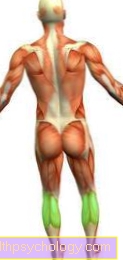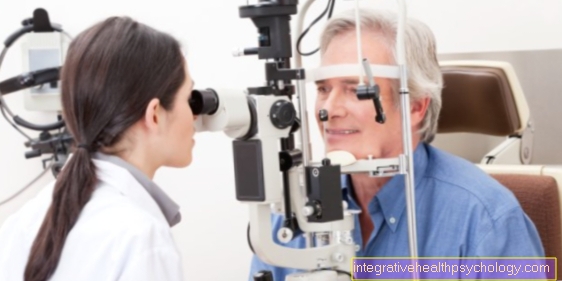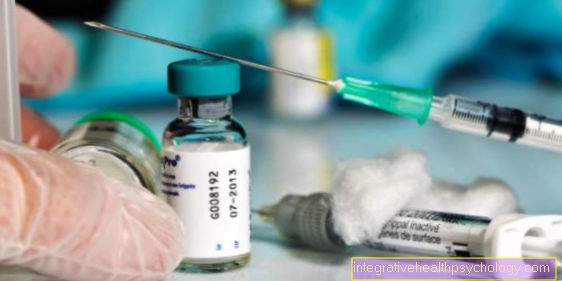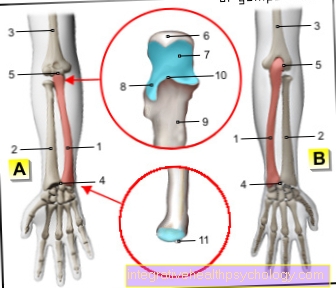Cardiovascular arrest
definition
If, due to a lack of (or non-productive) cardiac activity, the blood does not circulate in the affected person's vessels, this is referred to as (cardiac) cardiac arrest.

introduction
Cardiovascular arrest is an acutely life-threatening condition in emergency medicine. The sometimes congruent wording "clinical death" is misleading in that a cardiac arrest can be reversed if countermeasures are taken in good time.
While emergency chest compressions and ventilation (cardiopulmonary resuscitation / cardiopulmonary resuscitation) can, in the best case scenario, resuscitate the patient and possibly even get away without permanent damage, this approach is not always successful.
If the heart and thus the circulatory system of the person concerned do not get going again, irreversible death is the inevitable consequence of cardiovascular arrest without artificial maintenance of the blood circulation in the course of appropriate medical apparatus. If this occurred unexpectedly and suddenly, it was a so-called sudden cardiac death.
For more information about cardiac arrest, read our comprehensive article:
- Cardiac Arrest - Causes & Immediate Actions
- First aid
causes
The vast majority of cardiovascular arrests observed occur in association with coronary artery disease (CHD) or with severe cardiac arrhythmias. An enlarged heart (dilative or hypertrophic cardiomyopathy) can also cause cardiovascular arrest.
Other diseases leading to severe cardiac arrhythmias are rarer, as are other congenital, genetic and acquired defects in the anatomical or electrophysiological structure of the heart. Deviations in the concentrations of potassium (hyper- or hypokalaemia), calcium (hypercalcaemia), magnesium (hypomagnesaemia) or H + ions (acidosis) in the blood from their optimum levels can also trigger cardiac arrest.
In extreme cases, a strong allergic reaction (anaphylactic shock) as well as overactivation of the so-called sympathetic nervous system, for example due to severe stress, can lead to cardiovascular arrest.
Also seldom, but possible, is the opposite as the cause, an overstimulation of the so-called parasympthic regulation of the heart's activity, for example by one in the esophagus (Esophagus) stuck foreign body, which then by exerting pressure on the parasympathetic nerve cord leading to the heart (Vagus nerve) slows the heart rhythm so much (Bradycardia) that the heart can finally come to a standstill. This so-called vagal reflex can also be caused by sudden cold, such as jumping in ice water or sudden very severe pain or force on the upper abdominal nerve plexus (Solar plexus) to be triggered.
Another mechanical-reflex cause for cardiac arrest is the carotid sinus syndrome. In this syndrome, the cells in the large cervical arteries that measure blood pressure report (Carotids) due to pressure (from outside or inside, e.g. by a tumor) or incorrect regulation, incorrectly high blood pressure. Thereby they inhibit the heart's action. On the other hand, applying strong pressure - for example in the event of an accident - on the heart itself is a possible cause.
In rare cases, poisoning or medication (overdoses) (such as with diazepam or antiarrhythmics), as well as drug use (cocaine) are the cause of cardiovascular arrest.
Also a general lack of pumpable blood (Hypovolemia) a mechanical obstruction of the heart's action, for example due to fluid in the pericardium (pericardial tamponade), are possible reasons.
Furthermore, severe lung problems (e.g. pneumothorax or pulmonary embolism) or damage to the brain (e.g. as part of a stroke) can lead to cardiac arrest, as can overheating of the body (hyperthermia) or an electrical accident.
In general, cardiac arrest can be classified into one of the following categories, depending on the cause:
- In so-called asystole, the heart is neither electrically nor mechanically active, while electromechanical decoupling is characterized by the lack of transmission of electrical signals to the heart muscles of the ventricles and / or atria, which otherwise contract towards them.
- The functional total failure of the heart in pulseless ventricular tachycardia is based on such a high contraction repetition rate of the heart that the pauses between pumping (diastoles) are too short for blood to flow into the heart during them.
- Finally, ventricular fibrillation arises from the fact that incorrectly “circling” excitations in the ventricle lead to non-stop, uncontrolled contraction of the heart, which also prevents pumping functionality.
diagnosis
Of the Cardiovascular arrest solves a number of distinctive physical changes out. Logically, if there is no cardiac pumping then also no more pulses palpable. That's happening right now large arteries again Carotid artery (Carotid artery) and the Femoral artery (Femoral artery) these are almost always palpable in the bar. A few seconds later occurs usually loss of consciousness a, followed by gasping after about half a minute and Apnea after a full minute.
Other signs that also occur, such as blue coloring of the skin (cyanosis), absence of reflexes, cramps, rigidly dilated pupils or lack of pulse in other arterial vessels are considered unsafe characteristics, as they can also have other causes.
therapy

At Presence of cardiovascular arrest must get one asap Cardiopulmonary resuscitation to be started since already after a few minutes without blood supply the brain suffers irreparable damage. So in many situations it is imperative that this measure alongside Sending a help and emergency call is taken immediately by the next possible person. Since this however often medical laypeople unfortunately this will sometimes occur in reality Fear of making mistakes fail. However, it can be said that in such a situation nothing is worse than that Do nothing and also one unsafe or even buggy carried out Chest compressions and ventilation Can save lives.
In a clinical setting or after the emergency services have arrived at the emergency location, depending on the cause, a electronic shocking of the heart muscle (Defibrillation or cardioversion) and the administration of Emergency medication (Amiodarone, adrenaline) be helpful.
Does the Resuscitation unsuccessful, there is then the option of intensive care Heart and lung activity to replace equipment.
In parallel with resuscitation attempts, clinical staff can also try to find and correct the cause of the cardiac arrest.
Prevention
A distinction is made here Primary prevention, so that Lower the probability of occurrence cardiac arrest by a healthy lifestyle On the one hand, and tertiary prophylaxis, i.e. preventing a recurrence of such an incident by changing behavior, Medication or implantation of pacemakers or defibrillators.
A secondary prophylaxis, i.e. early detection of the disease as part of a Screenings is not possible because of its suddenness. Only relevant risk factors like that coronary heart desease can be recognized and treated at an early stage, thus reducing the likelihood of cardiac arrest.
forecast
Most important prognostic factor is how quickly after the onset of cardiac arrest using Resuscitation measures is started, which is often in the Medical layperson's responsibility who happen to be present in the situation or the patient unconscious and pulseless and should then take courageous action, which in practice is often neglected for fear of mistakes.
Depending on the cause of the Cardiovascular arrest, but above all it depends on how quickly and successfully a resuscitation was made is the Forecast very different and ranges from definitive death until full recovery. Often the patient stays for undefined time depending on the equipment taking over the heart and lung function, also one subsequent coma of very variable depth and duration is possible. In spite of successful resuscitation are, depending on the length of the condition, without circulation or with only makeshift resuscitation cognitive deficits possible or even to a small extent likely and pronounced, because the brain is very susceptible to undersupply.
In most cases it is for patients who have one Cardiovascular arrest survived significantly increases the likelihood of experiencing it again. Also for other diseases such as the so-called Lance Adams Syndrome, where as a result of the Lack of oxygen in the brain Muscle cramps arise, the probability of the disease is increased as a result.























.jpg)





